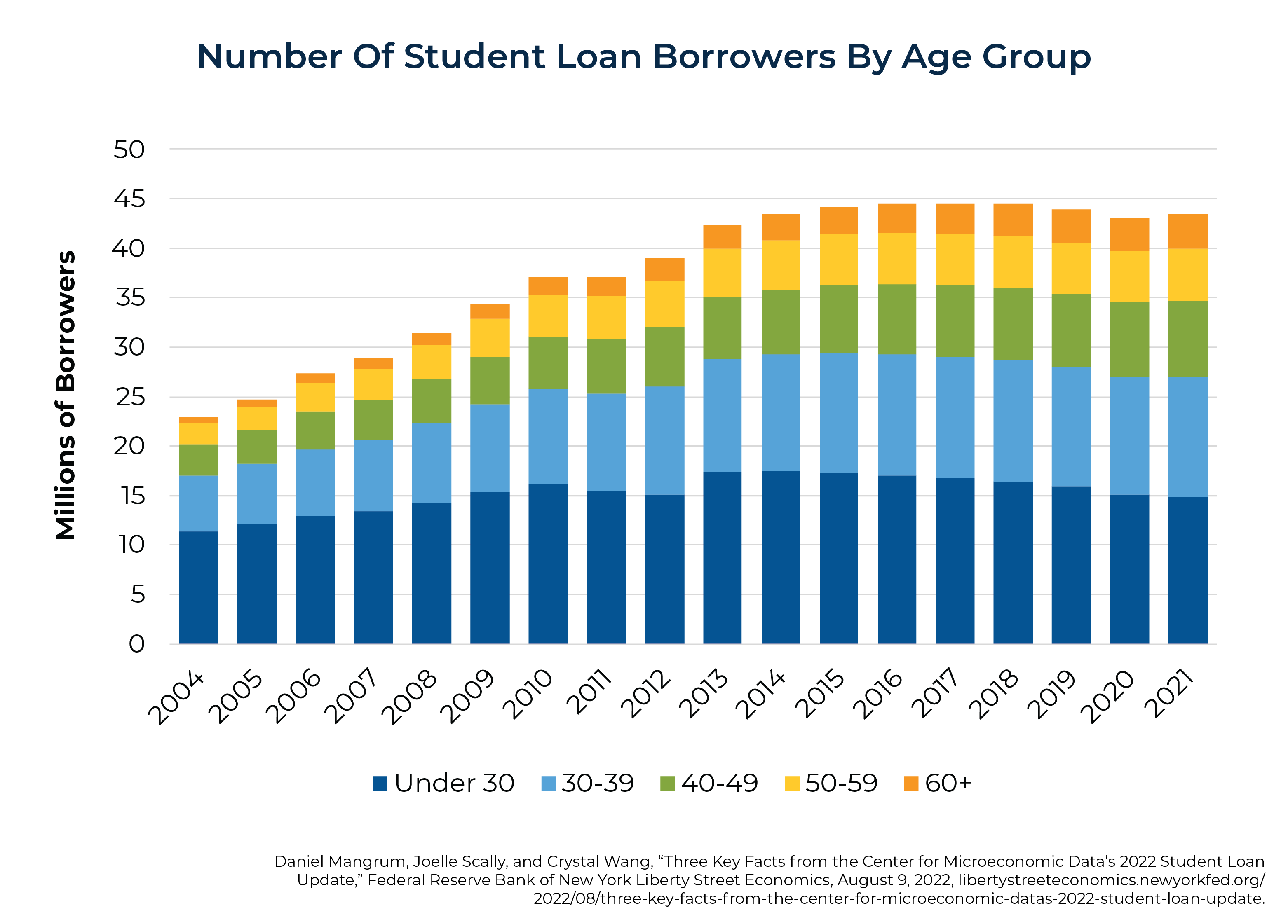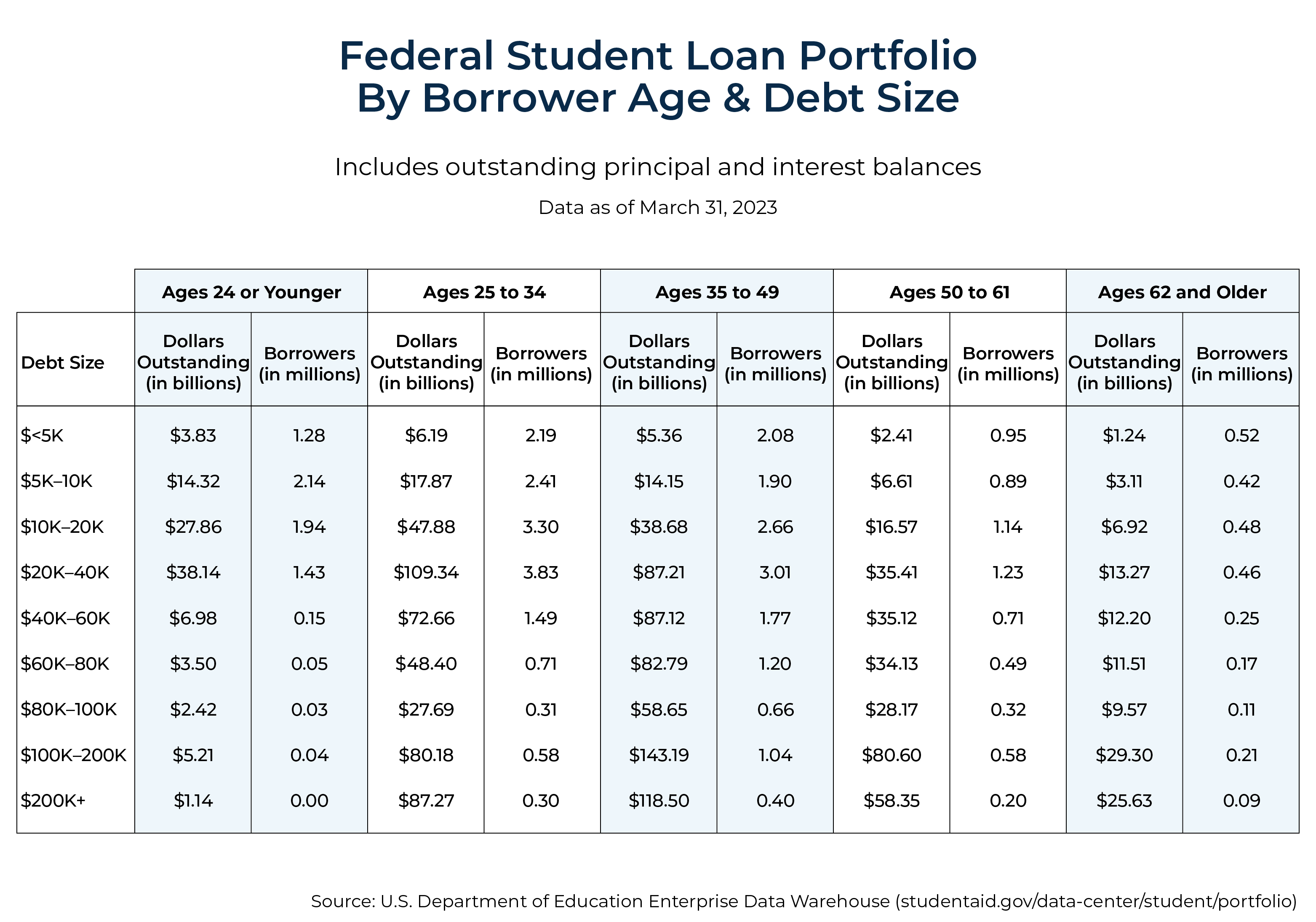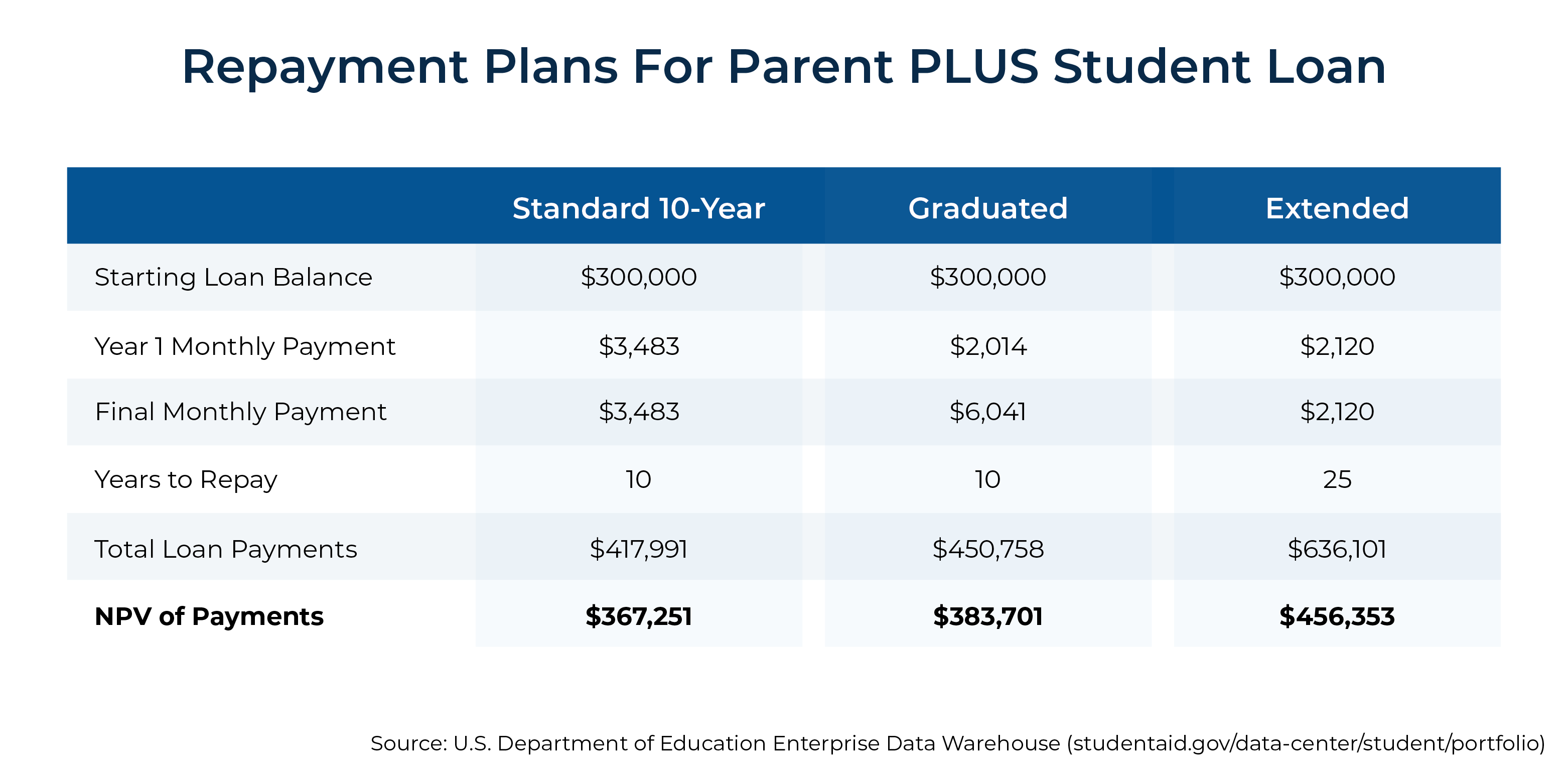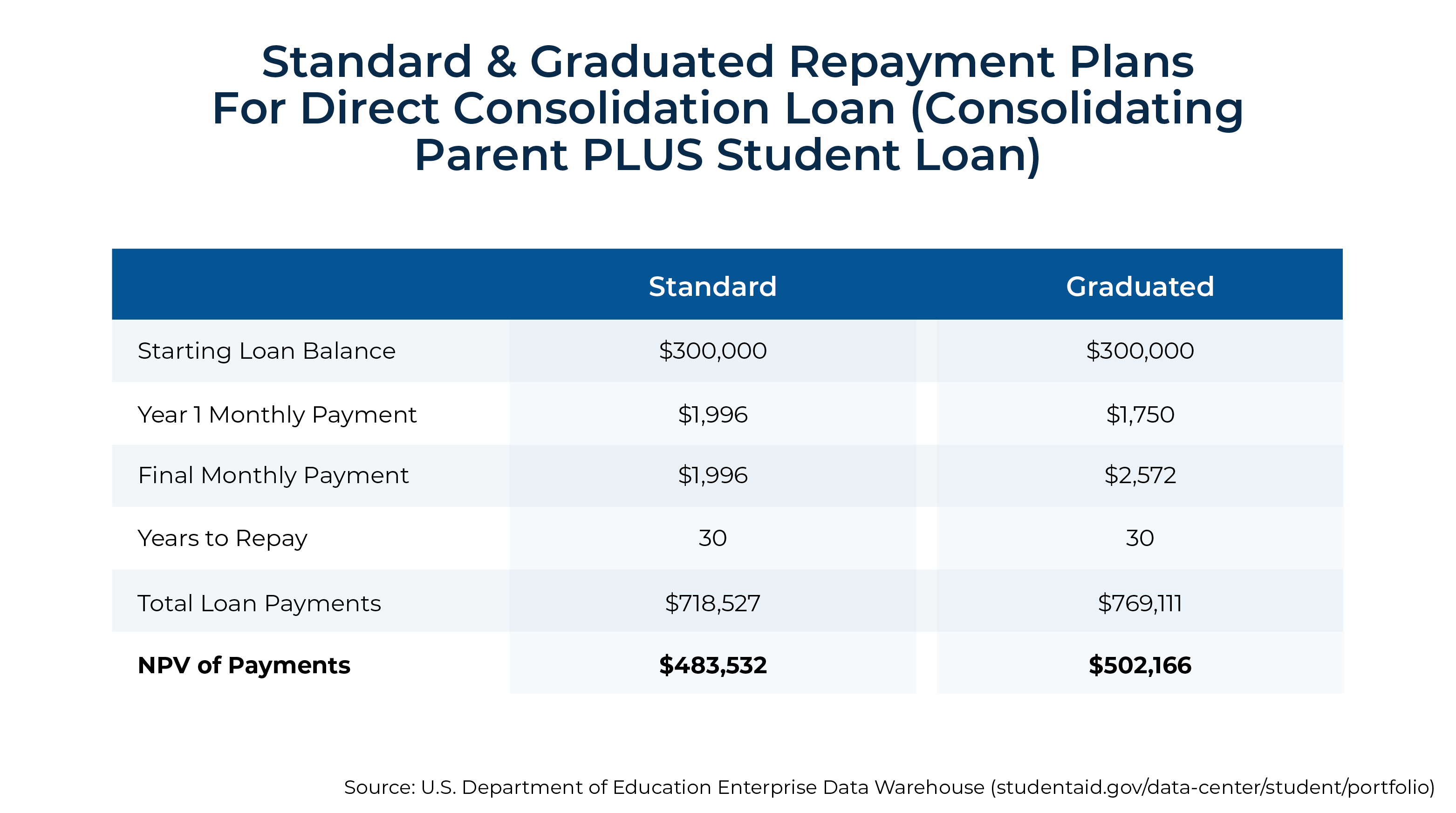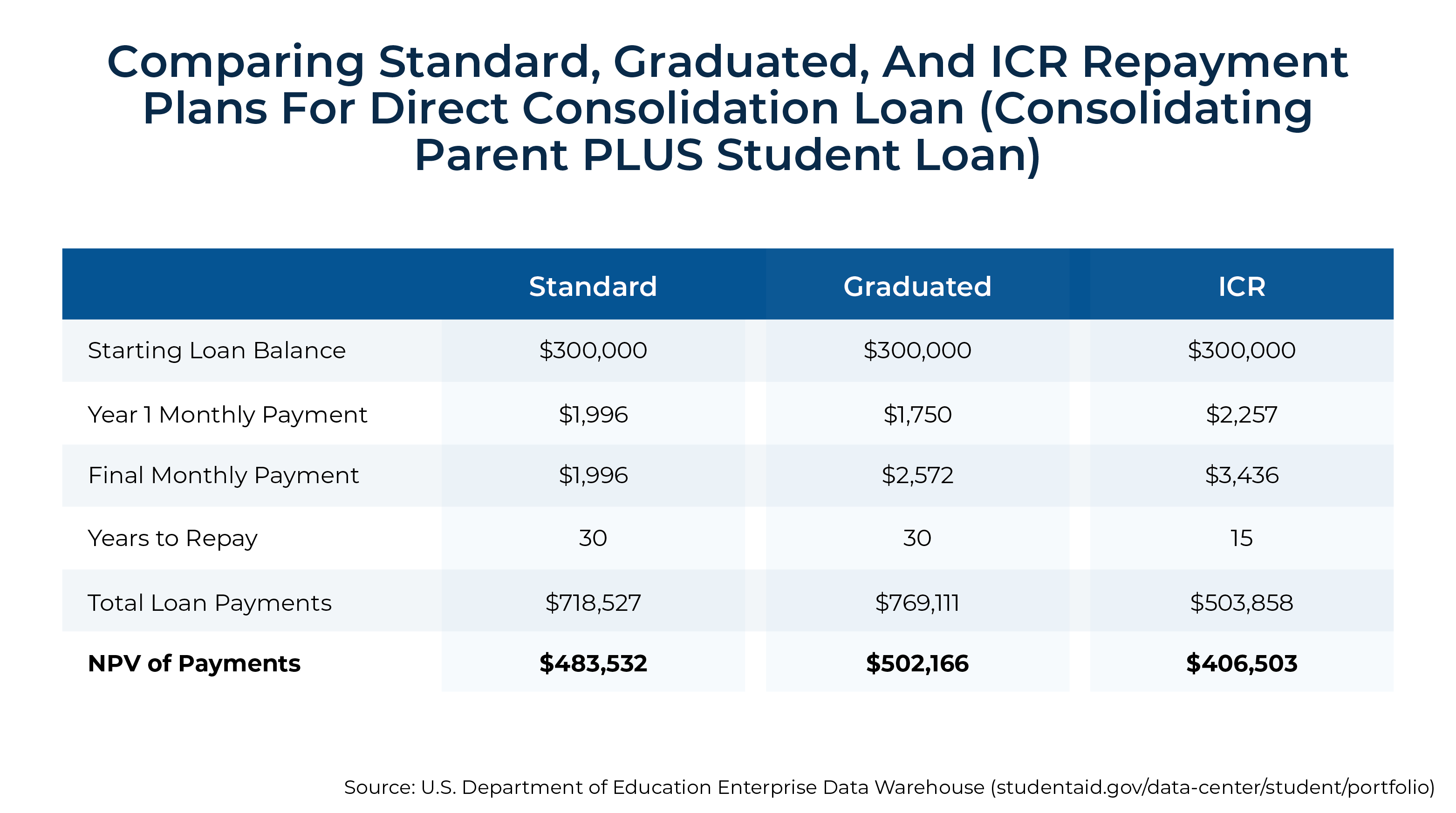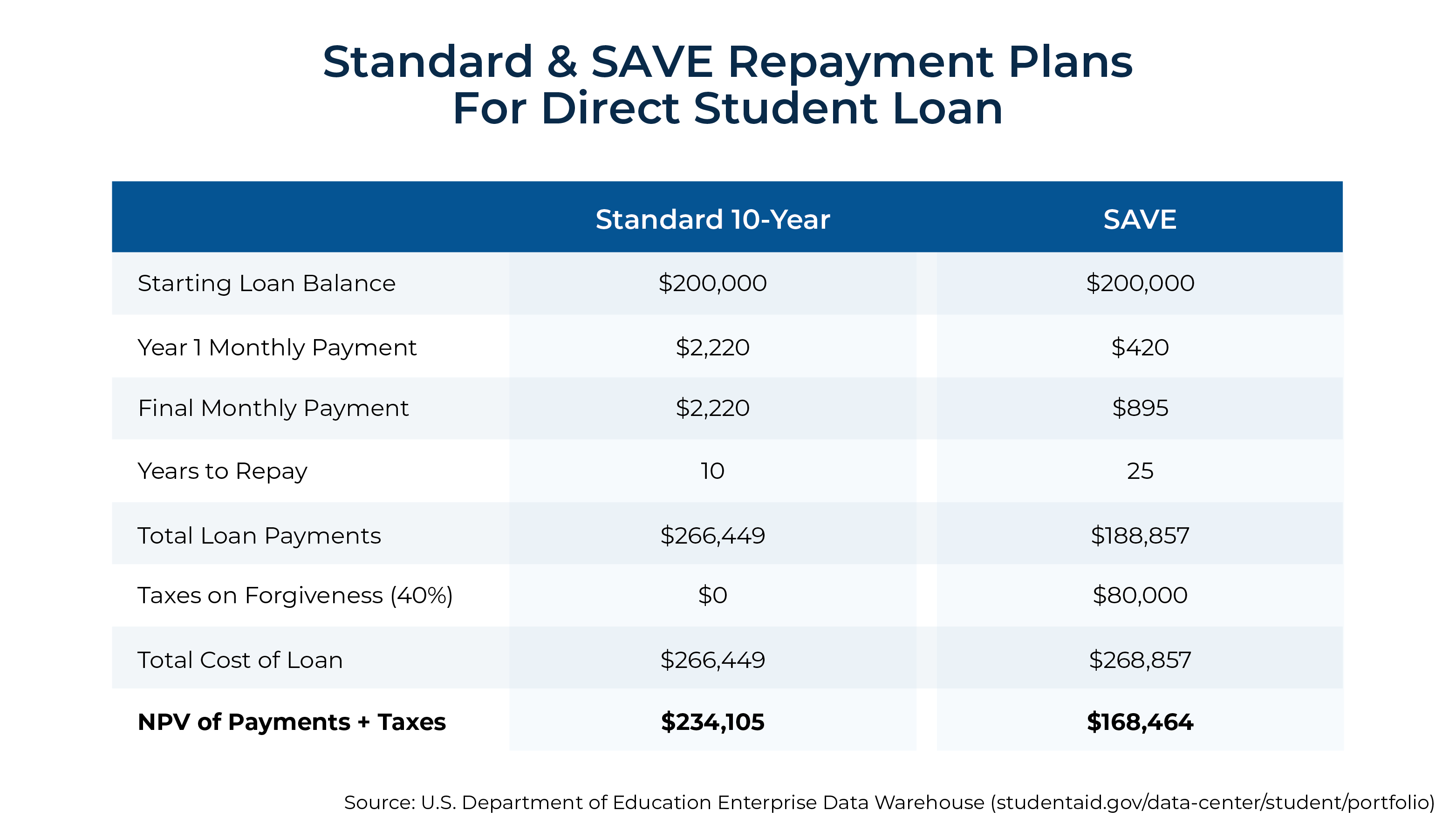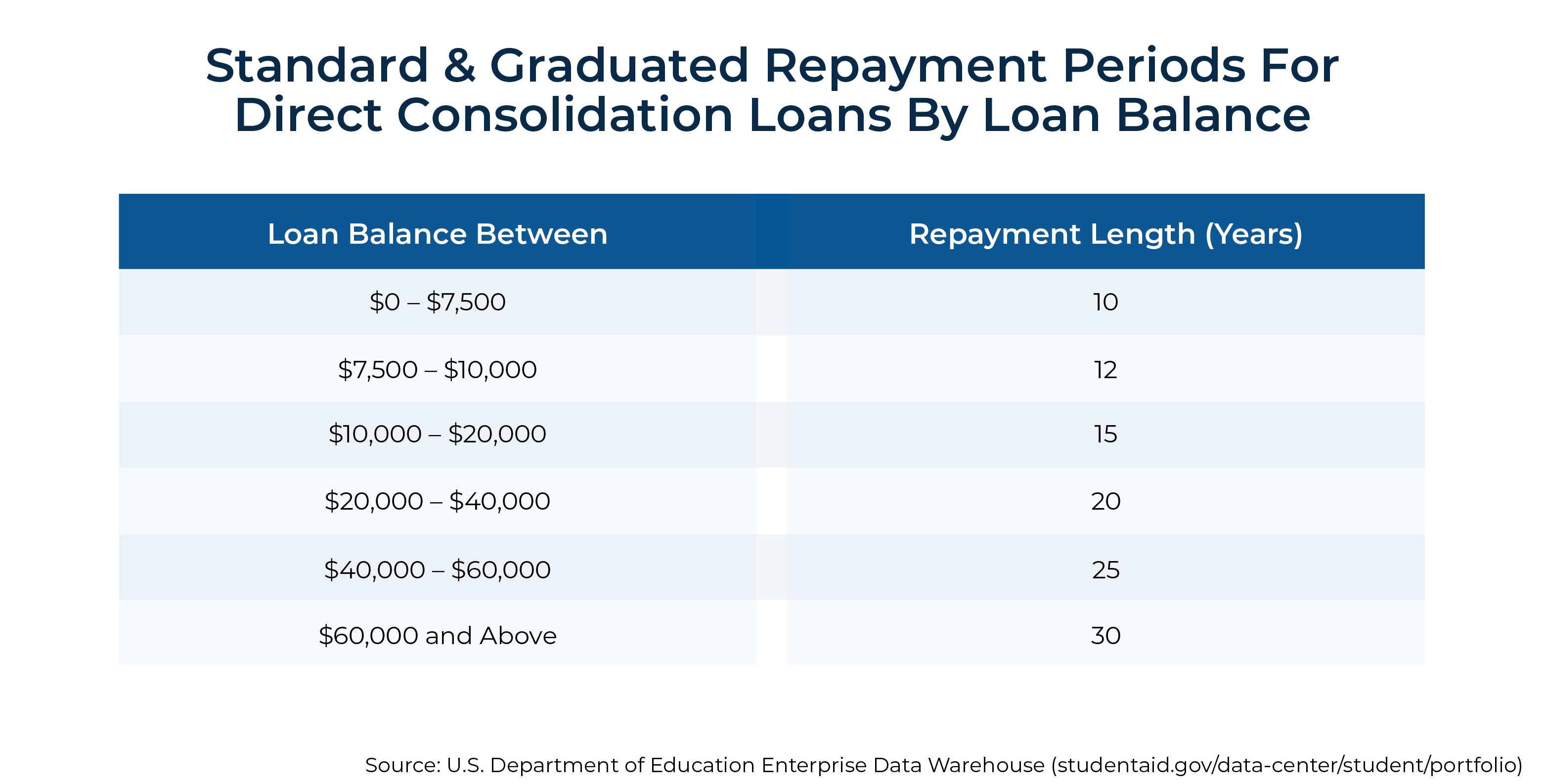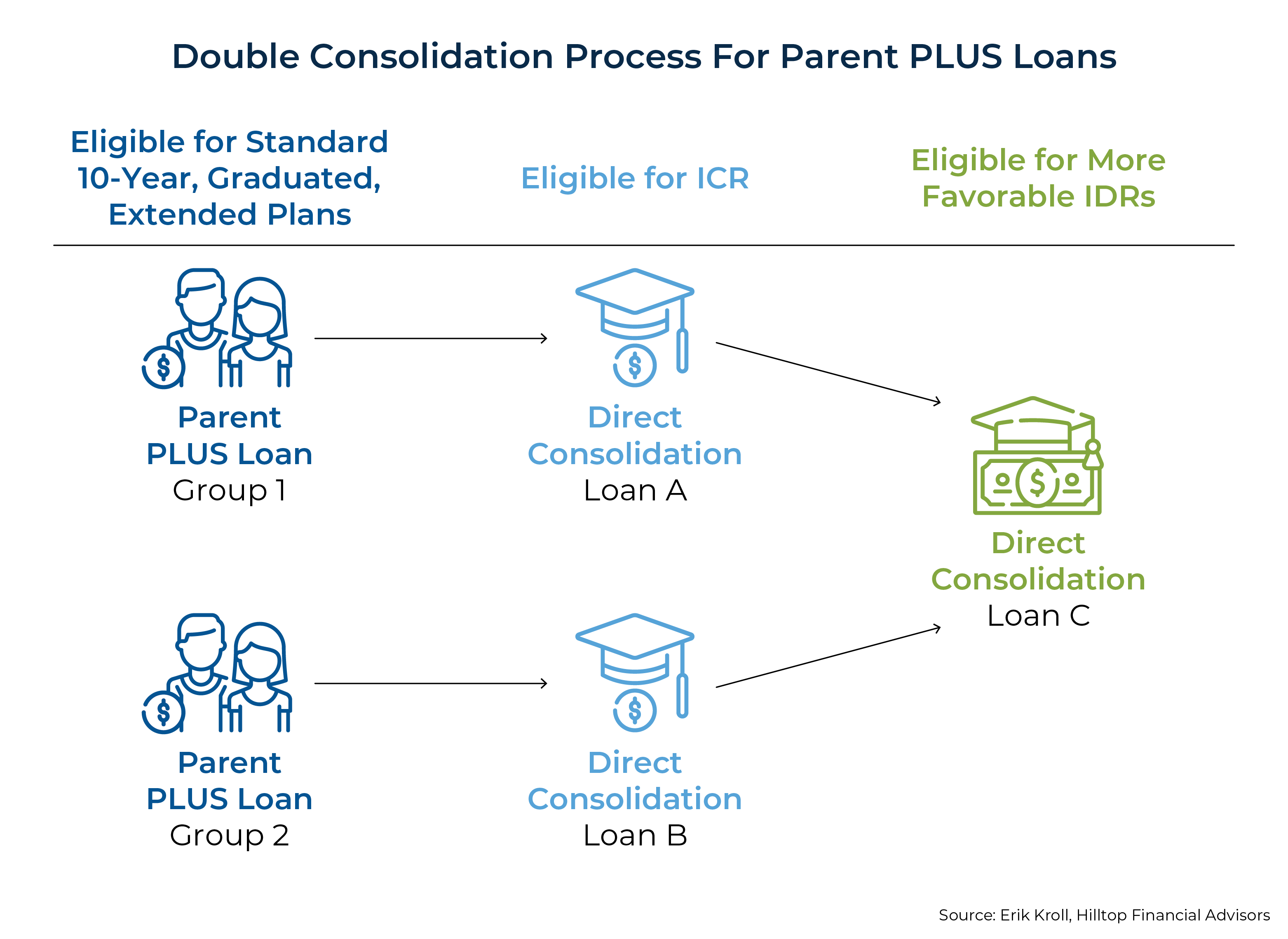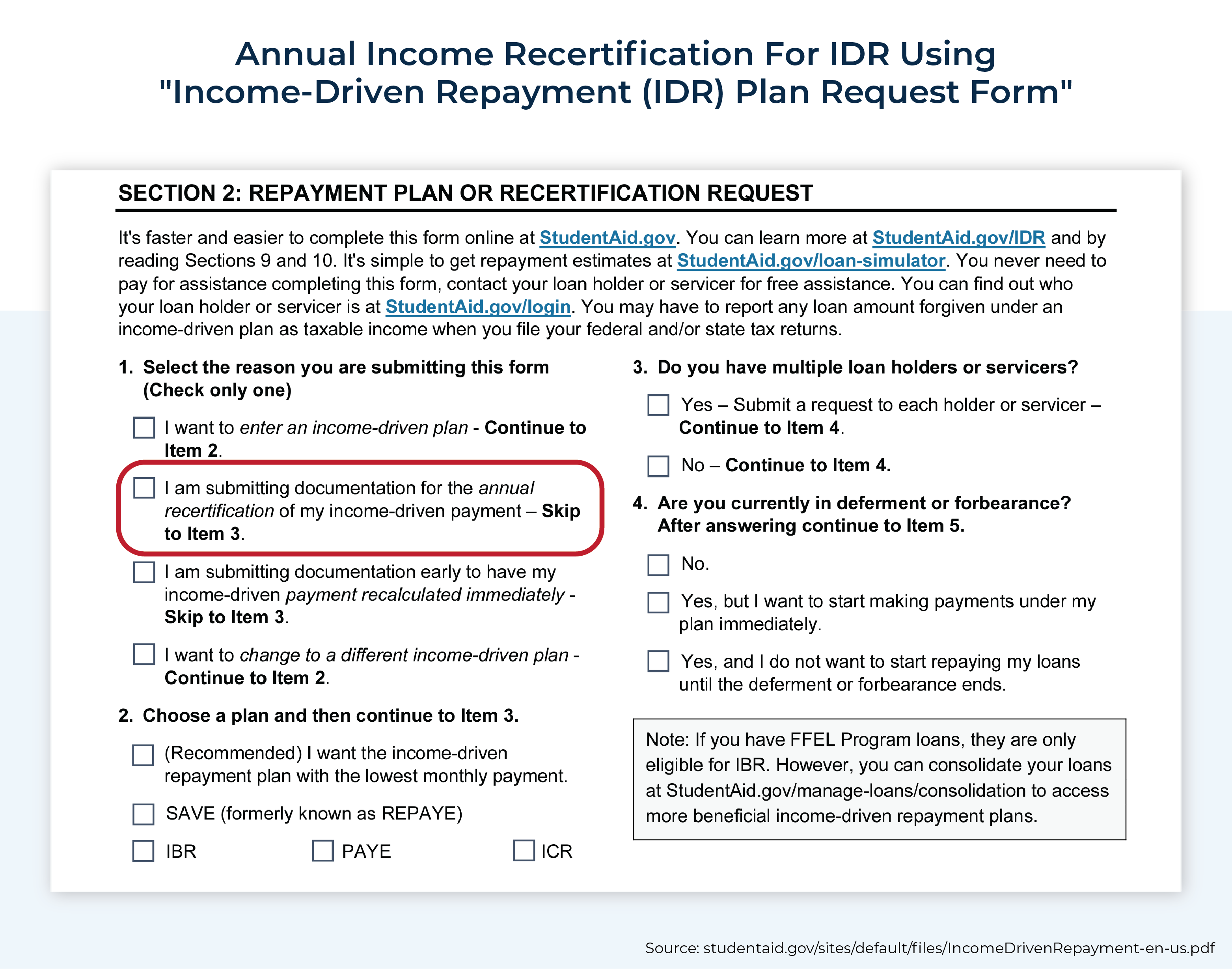Executive Summary
When it comes to advising clients on student loan issues, many financial advisors might first think about recent graduates seeking advice regarding the most effective way to pay down their balances. However, the number of Federal student loan borrowers over the age of 50 has increased significantly in the past 20 years, with many of these borrowers holding Parent PLUS loans that were used to help fund their children's undergraduate education.
While student borrowers of Federal Direct loans are eligible for a range of Income-Driven Repayment (IDR) plans – including the newly introduced Saving on a Valuable Education [SAVE] plan – that can reduce required monthly payments significantly compared to the standard repayment option (depending on the borrower's income), available IDR plans for those with Parent PLUS loans are much more limited, often resulting in substantially larger monthly loan payments. Which not only cuts into a parent's current cash flow, but also limits their ability to save for their (potentially fast-approaching) retirement.
Nonetheless, Parent PLUS borrowers (and their advisors) have an opportunity (until July 1, 2025) to access more generous IDR plans by using a "Double Consolidation" loan strategy. With this option, a parent borrower first consolidates their existing Parent PLUS loans into 2 Direct Consolidation loans, and then consolidates these 2 Direct Consolidation loans into a single new Direct Consolidation loan. The resulting loan would be eligible for more favorable IDR plans, including the SAVE plan, otherwise unavailable for those with Parent PLUS loans. Importantly, while this process might seem relatively straightforward on the surface, the multi-step process must be completed accurately and completely to ensure that the resulting Direct Consolidation loan is eligible for preferential IDR options.
Notably, given the looming July 2025 deadline and the importance of completing the Double Consolidation process (which can involve many paper forms and take 3–6 months in total) accurately and in a timely manner, advisors can play an important role in guiding clients with Parent PLUS loans through each step of the process. Further, advisors can help clients who complete the process choose the best IDR option for their situation and take steps to minimize required payments, from deciding whether to elect to file taxes separately (for married couples) to finding ways to reduce the borrower's Adjusted Gross Income.
Ultimately, the key point is that as more individuals 50 and older hold student loans, financial advisors may find that an increasing number of clients are facing the challenge of paying down loans taken out for their children's education expenses while also trying to save for their own retirement. And for those clients who currently have Parent PLUS loans (or who are planning to have such loans and who can complete the consolidation process before July 2025), advisors can add significant value by supporting them through the complex process of Double Consolidation, which could be an effective way to help them save on their children's education and, at the same time, to free up more of their wealth to pursue more of their other important financial goals!
Student loan planning is complex. While this complexity can have detrimental financial impacts that can lead to a lot of confusion for borrowers, it can also serve to create a lot of flexibility, providing opportunities to borrowers who know how to navigate the student loan and repayment systems.
Nowhere is this truer in the student loan planning realm than with Parent PLUS loans. Parent PLUS loans are loans for parents to cover the cost of their dependent child's undergraduate college costs (including attendance less the amount of aid – including Federal undergraduate loans – provided to the child). And since the amount an undergraduate student is allowed to borrow for a Federal Direct loan is limited, it is often up to the parents to help their children by financing additional expenses with Parent PLUS loans.
Further eligibility requirements for these loans are generally lenient: As long as the parent doesn't have an adverse credit history (basically, no delinquencies, defaults, or bankruptcies), the parent is typically eligible. Importantly, these loans are in the parent's name only. And while many families may create verbal agreements requiring the child to pay their parents back, the child for whom the loan was taken has no legal responsibility to repay a Parent PLUS loan.
Yet, even though Parent PLUS loans offer students and their families an opportunity to finance education expenses, the interest rates and fees on Parent PLUS loans are higher than those on undergrad loans (as of 8/3/2023, these are 8.05% versus 5.50% and 4.228% vs 1.057%, respectively). So, dollar for dollar, the Parent PLUS loan has a significantly higher payment requirement than an undergrad loan if utilizing a fixed repayment plan.
Given the challenges of borrowing through Parent PLUS loans to pay for their children's education, parent borrowers (and their advisors!) should be aware of strategies and tools that can help them better manage their student debt load. One such strategy, the "Double Consolidation" process, enables parent borrowers to, in effect, consolidate their Parent PLUS loans twice in order to access more beneficial repayment plans (including the newly available SAVE Plan), which can potentially cut loan payments by more than half.
Importantly, though, given the recent changes introduced through the Biden Administration's student loan reform programs, this option is only available through June 30, 2025. More specifically, the new legislation states:
...a Direct Consolidation loan made on or after July 1, 2025, that repaid a parent PLUS loan or repaid a consolidation loan that at any point paid off a parent PLUS loan is not eligible for any IDR plan except ICR.
So, while current holders of Parent PLUS loans (along with those who will see their child finish school before the end of 2024) still have time to fully take advantage of this process, parents who have yet to take out the bulk of their Parent PLUS loans after 2024 should be aware that this ability will no longer be available after July 2025.
Fortunately, borrowers of Parent PLUS Loans who can benefit from this strategy still have time to use the strategy, which can save them large sums of money on their loans, allowing for even more dollars to be saved for the things that matter to them most.
The Planning Opportunity for Parent PLUS Student Loan Borrowers
Parent borrowers over age 50 who have large student loan balances are among a significant and growing portion of the population. Based on data provided by research from the Federal Reserve Bank of NY and Equifax, from 2004 to 2021, borrowers in the 50-59 and 60+ age groups had the largest percentage increases compared to any other age groups. They also saw the highest percentage change in loan balance per borrower in the 50–59 and 60+ age groups between 2004 and 2021, and an average debt load per person over 50 was calculated to be above $40,000 in 2021.
Borrowers over age 50 are also more likely to need and seek the help of a financial advisor since the complexity of their situations is high and the consequences of mismanaging the dollars at stake become much higher. For example, when a Parent PLUS loan borrower carries a balance at or above their income, locking themselves into a repayment plan based on 20% of income (e.g., through the Income-Contingent Repayment Plan – the only IDR plan available to Parent PLUS borrowers, provided they consolidate their loans) because they don't realize there are strategies that can qualify them for repayment plans that require lower monthly payments, the resulting situation can cost them tens of thousands of dollars over the course of a decade (or more)!
According to the U.S. Department of Education Office of Federal Student Aid, there were over 1 million individuals over age 50 with Federal student loan balances above $100,000 as of March 31, 2023.
Notably, while this data shows the total number of borrowers with Federal student loans and doesn't distinguish between Parent PLUS loan borrowers and non-Parent PLUS loan borrowers, from my own experience (and through hearing from other student loan experts), the vast majority of older borrowers involve Parent PLUS loans (or consolidation loans that paid off parent plus loans), which might suggest that a large number of loans among borrowers over age 50 can be presumed to be Parent PLUS loans or Direct Consolidation loans that paid off Parent PLUS loans.
Furthermore, in April 2019, the Urban Institute released a report, "Reshaping Parent PLUS Loans: Recommendations for Reforming the Parent PLUS Program", to address the growing use of Parent PLUS loans that exceed borrowers' expected family contributions, resulting in loans that ultimately cannot be repaid. Their research suggests that "Parent PLUS borrowers have higher incomes and more assets than nonborrowers", providing the following assessment of their findings:
Among the families of dependent first-year students in 2015–16, 30% of those with household incomes above $100,000 took out Parent PLUS Loans, while just 16% of families with incomes below $20,000 used these loans. High-income families tend to take out larger loans as well. The median first-year PLUS loan amount was about $7,000 for households with incomes below $20,000 but $17,850 for households with incomes above $100,000. In 2015–16, about 40% of Parent PLUS dollars went to the 25% of parents in the highest income quartile.
So even though many Parent PLUS borrowers may belong to a subset within a subset of the population that financial advice hasn't traditionally covered, many of them potentially do have higher levels of wealth and income and may be starting to plan for (or have already begun) retirement. Which means there is a good chance that advisors may come across one or more of these cases in the future, if they haven't already!
Decisions Faced by Parent PLUS Borrowers
Parent PLUS loan borrowers whose children have not yet graduated can decide either 1) to let the loan enter repayment or 2) to go into deferment until 6 months after their child graduates from college. With either choice, interest starts accruing immediately. The borrower can decide to make payments on the interest (and principal), even in deferment. For loans in deferment, any interest on the loan is capitalized when the deferment period ends, resulting in a higher principal balance than what the borrower originally started with. Parent PLUS loans qualify for 3 repayment plans:
- Standard Repayment: Fixed payments are amortized over 10 years;
- Graduated Repayment: Fixed payments start off lower and gradually increase every 2 years over a 10-year term; and
- Extended Repayment: Fixed or graduated payments made for up to 25 years for overall Federal loan balances of more than $30,000.
Example 1: Dr. Steven is 55 years old with 3 kids. He earns $150,000/year and has a Parent PLUS student loan balance of $300,000.
Here are his eligible repayment plans along with their starting monthly payments, assuming a 7% annual interest rate and fixed payments for the Extended Repayment option:
How Direct Consolidation Loans Provide Parent PLUS Borrowers With Additional Options
If the parent borrower decides to consolidate their Parent PLUS loans through a Direct Consolidation Loan, their interest rate is determined by the weighted average interest rate of the loans being consolidated, rounded up to the nearest 1/8%. It is important to note that a Direct Consolidation Loan is done through the Federal loan system and not through refinancing with a private lender.
Direct Consolidation loans are also eligible for the Standard, Graduated, and Extended Repayment plans, though the Standard Repayment and Graduated Repayment terms change for consolidated loan balances over $60,000, stretching from 10 years to 30 years (the Extended Repayment plan length stays the same at 25 years).
Example 2: Dr. Steven, from Example 1, wants to lower his monthly payments and chooses to consolidate his $300,000 Parent PLUS loans using a Direct Consolidation.
The repayment terms on the standard and graduated plans change as follows, again assuming a 7% interest rate:
In addition to lengthening the repayment terms on Standard and Graduated Repayment plans, consolidating Parent PLUS loans into a Direct Consolidation Loan can also qualify borrowers for one additional option: the Income-Contingent Repayment (ICR) plan. For borrowers who choose the ICR plan, payments are generally calculated by taking 20% of their discretionary income (calculated by deducting 100% of the current Federal Poverty Level (FPL), based on state and family size, from the borrower's AGI). Further, if the borrower makes payments for 25 years, any remaining portion of the loan is forgiven, though the forgiven balance is included as taxable income for tax purposes after 2025.
Unfortunately, out of the IDR plans available, ICR comes with the highest loan payment (20% of discretionary income versus 10% for most other IDR plans) and has a lower deduction against income. This payment structure makes ICR more expensive than other IDR plans, and many parent borrowers are likely to be in (or approaching) their highest earning years, which also creates an environment for a higher IDR payment.
Several assumptions need to be made when considering the ICR plan. In particular, since ICR monthly payment amounts are based on the borrower's income, future income is an important variable, as higher income levels will mean higher payments (and can even compromise the prospect of forgiveness if there is no remaining balance to forgive after 25 years). Which means that any changes in income due to retirement or how different sources of income are taxed (e.g., Social Security and Roth distributions) will have a substantial effect on calculated loan payments.
Example 3: Dr. Steven, from Examples 1 and 2, decides to investigate the additional ICR plan that is now available for his Direct Consolidation loan.
To determine how much his total loan payments will be, he assumes his current income of $150,000 will continue growing at a 3% rate of return over the entire loan period and that he will still be working by the time his loans are paid off – when he is age 70.
Under the ICR plan, Dr. Steven's payments are paid off in 15 years, in half the time that it would take him to pay off his loan under the Standard or Graduated repayment plan, but his payments are substantially higher – even higher than the graduated and extended repayment amounts without consolidation.
However, under Dr. Steven's current assumptions, he will work (and earn an inflation-adjusted salary) for the life of the loan. But if he were to retire earlier, prior to the end of the currently projected loan repayment period, resulting in a lower taxable income, this would reduce the payments made in the later part of the repayment plan and increase the likelihood that a balance would still remain after 25 years, and thus be forgiven!
The Benefits Of (Non-Parent PLUS) Federal Loans
For all the confusion and complexity that come with Federal student loans, they offer a lot of flexibility and protection to borrowers that traditional loans do not. The ability to qualify for an Income-Driven Repayment (IDR) plan and the forgiveness of remaining loan balances offered by an IDR plan (once certain criteria are met) are 2 central features that allow for massive savings on student loan repayment.
Income-Driven Repayment (IDR) plans, such as the Income-Contingent Repayment (ICR) plan (discussed earlier) and the new SAVE Plan, are based on the borrower's income level instead of the actual loan amount. This means annual payments are calculated – and periodically adjusted – as some percentage of the borrower's discretionary income (generally determined by AGI and a given multiple of the Federal Poverty Line) depending on the particular IDR plan.
Furthermore, while payments for most IDR plans are calculated as a fixed percentage of the borrower's discretionary income regardless of whether loans are graduate or undergraduate loans, beginning in Summer 2024, the SAVE plan will calculate monthly payments as 5% of discretionary income for undergraduate loans, 10% for graduate loans, and a weighted average for borrowers with both types of loans (until then, monthly payments for both undergraduate and graduate loans will be calculated as 10% of discretionary income).
Example 4: Sheila is a single borrower with an AGI of $150,000. In Summer 2024, she has $100,000 in Direct student loans: 50% are undergraduate loans with a 4% interest rate, while the other 50% are graduate loans with an 8% interest rate.
Sheila chooses the SAVE Plan, which determines discretionary income as her AGI less than 225% of the Federal Poverty Level. For 2023, Sheila's Poverty Level is $14,580, which means the discretionary income (which will be used to calculate her loan payments) Sheila reports is $150,000 – (225% × $14,580) = $117,195.
Since Sheila is opting for the SAVE Plan in Summer 2024, her loan payments will be calculated as a weighted average based on 5% of her discretionary income for her undergrad loans and 10% for her grad loans. Since she has $50,000 of undergraduate loans and $50,000 of graduate loans, the weighted-average multiplier used to determine her monthly payment is 50% × 5% (undergrad loan rate) + 50% × 10% (grad loan rate) = 7.5%.
Which means that Sheila's total annual loan payment will be 7.5% × $117,195 = $8,790, and her monthly payments will be $8,790 ÷ 12 = $732.47.
While fixed payment plans (such as the Standard and Extended Plans discussed earlier) allow borrowers to lower their monthly loan payments by increasing the repayment term, the result is more interest paid over time with a higher total cost of loan repayment. By contrast, repayment periods for IDR plans are capped at 20 or 25 years, which can result in a remaining loan balance at the end of the repayment term. At this point, the outstanding balance becomes eligible for forgiveness, and the forgiven amount is included as taxable income for the borrower. Relative to fixed payment plans, the savings of IDR plans can be immense, as not only can monthly payments be lowered substantially, the overall cost of repaying the loan can also be much lower, even though the repayment term length is longer!
Though not for all borrowers (e.g., those with high incomes who would repay their loan before having the opportunity to benefit from forgiveness), when IDR plans do make sense, the loan forgiveness feature can sometimes even result in the total cost of the loan being less than the balance of the current loan itself, even when accounting for the tax due on the forgiven amount! Generally, the incentive of loan forgiveness through an IDR plan increases as the disparity between (lower) IDR and (higher) standard repayment grows.
However, while assessing the benefit of loan forgiveness based on monthly payment amounts can help a borrower understand the impact on their current cash flow situation, taking a broader view of comparing total debt to taxable income can also be a useful way to assess whether loan forgiveness can make sense for the borrower. For instance, a rule of thumb that I use in my practice is that when Federal loan debt is 1.5 times the borrower's income, we need to consider loan forgiveness through IDR as a potential alternative for a borrower just entering loan repayment. By the time the loan balance is 2.5 times income, I find forgiveness works in the borrower's favor a majority of the time.
Example 5: Margaret is single and earns $100,000/year. She has a Direct student loan balance of $200,000, with 50% undergraduate loans and 50% graduate loans. She is on a standard 10-year repayment plan with a 6% interest rate and wants to determine if she should switch over to the SAVE Plan next year.
She assumes that her income will increase by 3%/year, and factors in the U.S. Department of Health and Human Services estimate (based on the estimate for January 2023) that the Federal Poverty Level will increase by 2.55% annually.
Given these assumptions, Margaret determines that her 1st-year payment on the SAVE Plan will be 7.5% (weighted average of grad/undergrad loans) × ($100,000 AGI – (225% × $14,580 FPL)) = $5,040 annually, or $420/month. She estimates that her monthly payments will increase to $895 over the course of 25 years.
If Margaret switches to the SAVE plan, her payments will always be substantially lower than the minimum payment of $2,220 required by the Standard plan, although she will pay for a longer time (25 years on SAVE versus 10 years on the standard plan).
Additionally, we'll assume a 40% tax rate on any forgiven balance. We'll use a 3% rate of inflation, which will allow for a net present value calculation of the plans, essential for comparing plans with different repayment lengths.
While the SAVE Plan may have a higher total cost (and may require Margaret to come to terms with having a longer repayment period), calculating the NPV of each option indicates that it would make more sense for Margaret to enter the SAVE plan.
Importantly, IDR payments are based on the borrower's AGI, which means that anything the borrower can do to lower their taxable income (e.g., through 401(k) plan contributions, health insurance premiums, etc.) will also lower their calculated loan payment and increase the total amount of loan forgiveness at the end of the repayment term.
Given that the tax on the forgiven balance can add a substantial amount to the total cost of the loan, the borrower may benefit by saving money over a period of 20 or 25 years for the ensuing 'tax bomb'. At a modest rate of return, this effectively lowers the all-in cost of the loan as well.
So, while making lower payments under a standard repayment plan would serve to increase the overall total cost of the loan through negative amortization, reducing payments as much as possible actually becomes the goal when pursuing forgiveness through an IDR plan. The optimal approach is to get the IDR payment as low as possible (as even a $0 payment under an IDR plan can count as a payment toward forgiveness).

Nerd Note:
How can a 'payment' of $0 count toward forgiveness? Borrowers are able to recalculate their monthly payment outside of the required every 12 months for any reason (e.g., a loss of or drop in income). If Margaret, in the example above, were to lose her job, she could recalculate her monthly payment immediately. So if she is now earning $0 income, her payment on the SAVE Plan would be 7.5% (weighted average of grad/undergrad loans)' ($0 income – (225% × $14,580 FPL)) = $0 annually, or $0/month (payments are never less than zero)!
How The Double Consolidation Process Tilts Things In The Borrower's Favor
While the Income-Contingent Repayment (ICR) results in a payment of 20% of the borrower's discretionary income, it would be much better if the borrower could utilize a more beneficial IDR plan like the Saving on a Valuable Education (SAVE) plan, which uses only 5–10% of discretionary income to calculate the payment. But ICR is the only eligible IDR plan that can pay off a Parent PLUS loan that has been consolidated into a Direct Consolidation Loan. What's a borrower to do?
Here, wording matters when it comes to the IDR plan eligibility requirements for consolidation loans. While a consolidation loan that pays off 1 or multiple Parent PLUS loans only qualifies for the ICR plan in terms of IDR plan eligibility (which is what most Parent PLUS borrowers do), a consolidation loan that pays off another consolidation loan (or 2), regardless of what that first consolidation loan paid off, qualifies for the other IDR plans! (However, as noted earlier, it is important to remember that this 'double' consolidation strategy can only be used through July 2025. After that, ICR will be the only IDR plan any borrower of Direct loans used to consolidate Parent PLUS loans – even a consolidation loan used to consolidate another consolidation loan that paid off a Parent PLUS loan – will be eligible to use.)
This wording that describes a consolidation loan eligible for IDR is what opens the door for Parent PLUS borrowers to use payment plans eligible for forgiveness other than ICR with much lower payments. Since lowering the student loan payment ultimately increases the total forgiveness amount, this process has an outsize effect on driving down the borrower's overall cost of the loan.
Much like needing to take an indirect route through backdoor Roth contributions when a client's income is too high, this process takes an indirect route to the more favorable IDR plans. This results in a much lower payment than ICR, many times by over half!
Since this strategy is almost exclusively paired with the pursuit of loan forgiveness, this does 2 things. First, it reduces the loan burden, both now and over the total cost of repayment. Second, this allows the borrower to use those savings for other purposes, like boosting retirement savings.
How To Do The Double Consolidation Process
Double consolidation of Parent PLUS loans is a complicated process, layered on top of the already complex Federal student loan system. Mistakes here can be costly, inadvertently sending the borrower back into only being eligible for ICR. Consolidations need to take place through the Federal loan system, using what's known as a Direct Consolidation loan. For Federal loan purposes, a Direct Consolidation is done through the Federal loan system. If a private lender is used, the loan is taken out of the Federal system, disqualifying the borrower from any of the Income-Driven Repayment plans and forgiveness programs available. In order to use the double consolidation loan process, loans must be consolidated into Direct Consolidation loans within the Federal loan system.

Nerd Note:
While the terms "consolidate" and "refinance" are often confused by borrowers, loans can only be "consolidated" into a Direct Consolidation loan; when a private lender enters the picture, those loans are 'refinanced' into private loans.
Almost all Federal student loans are eligible for a Direct Consolidation loan as long as the loans are solely in the borrower's name (no consolidating a parent's Parent PLUS loan with the child's undergraduate loan). And while privately held student loans aren't eligible for Direct Consolidation, Federal Family Education Loan (FFEL) Program loans held by private lenders are eligible for Direct Consolidation since they were guaranteed by the government.
Importantly, a single Direct Consolidation loan cannot be consolidated into another Direct Consolidation loan if it is the only loan for the borrower – there must be at least 1 additional loan that must be included in the consolidation. Which means that a common pitfall to avoid is consolidating loans in such a way that only one Direct Consolidation loan remains. If Parent PLUS loans are the only loan type in the borrower's inventory, there needs to be at least 2 of them since an individual Parent PLUS loan can be consolidated by itself. Fortunately, this typically doesn't create problems since most parents take out a new loan for each year their child is in school.
To determine the interest rate of a new Direct Consolidation loan, the weighted average interest rate from the loans that were paid off is rounded up to the nearest 1/8th % (it does not lower the interest rate). The new standard repayment term is 10–30 years, based on the balance of the new loan.
The following table shows how the length of the loan repayment period depends on the consolidated balance under the Standard and Graduated Repayment plans:
Even though the process is referred to as a "double" consolidation, there are actually 3 separate consolidation steps: The first 2 steps involve the Direct Consolidation of Parent PLUS loans, and the 3rd involves Direct Consolidation of the first 2 Direct Consolidation loans. The process is considered a "double" consolidation because there are 2 phases that involve different types of consolidation, where Phase 1 consists of consolidating Parent PLUS loans to Direct Consolidation loans, and Phase 2 consists of consolidating at least 2 Direct Consolidation loans to a new, single Direct Consolidation loan.
Example 6: Steven has 12 Parent PLUS loans, originally taken out for his 3 children. At the direction of his financial advisor, Karen, they implement the Double Consolidation process.
In Phase 1, Steven consolidates 6 of his loans in 1 Direct Consolidation loan, and the other 6 of his loans in another Direct Consolidation loan. He waits for both consolidations to complete before moving on to Phase 2.
In Phase 2, he consolidates the 2 Direct Consolidation loans into 1 final Direct Consolidation loan. This final consolidation loan will be eligible for various IDR plans, including the SAVE Plan (at least until June 2025).
This process can be lengthy, but borrowers (and their advisors!) can watch for mistakes and will often have a chance to correct them if necessary. For example, each loan servicer communicates with the borrower as to what is being done throughout the loan process (e.g., which loans are being consolidated, what repayment plans are entered, etc.) and will let the borrower know if they see any errors in the forms. Many of these errors are relatively simple processing errors (e.g., the form wasn't read properly by the servicer or filled out correctly by the borrower) that can be corrected, sometimes through a phone call or by re-sending a form. Other errors that are more serious (e.g., when the wrong combination of loans are or aren't being consolidated together) will typically require the borrower to remedy the situation via a phone call within 10 business days.
When planning for the Double Consolidation process, it is important to keep in mind that the total time to complete can take 3-6 months. While I've received estimates from servicers of 30–90 days for each consolidation, I've seen things get completed on both ends of this range, depending on how backed up loan servicers are at any given moment. The official answer online is that consolidations take about 6 weeks to complete. You'll have 2 consolidation windows for the Double Consolidation process: one for Phase 1 (since both consolidations here can be started at the same time) and one for Phase 2.
Phase 1: Consolidating Parent PLUS Loans To Direct Consolidation Loans – Process And Forms
In Phase 1, Parent PLUS loans are split into 2 groups, where each group will be consolidated into its own Direct Consolidation loan. The split can be arbitrary, though borrowers with more than 1 child often like to split the loans based on which child the loan was taken out for (e.g., all the loans for Child 1 in one consolidation and all the loans for Child 2 in the other consolidation).
While a Direct Consolidation loan can be processed online through the Federal Student Aid website at studentaid.gov, the online process can only be done once in a 180-day period (essentially, no more than once every 6 months). Notably, the online loan application usually has a shorter processing time due to electronically filed forms having a lower probability for errors relative to mailed paper forms. Furthermore, since borrowers will be required to submit paper forms for at least one set of their Phase 1 consolidations, saving the online process for the final round of consolidations during Phase 2 can potentially shave some time off the overall length of the Double Consolidation process (though the processing time will still ultimately dependent on the servicer). Therefore, it is usually better to do each of the Phase 1 consolidations using paper forms mailed to the appropriate loan servicers.
Another important consideration to plan for when using the double consolidation process is that each separate consolidation will need to be completed with a different eligible loan servicer since only 1 consolidation with a servicer can also be done in a 180-day period. A list of servicers can be found on the Federal Student Aid loan consolidation website, which means that borrowers can choose the specific servicer they want to use for their final consolidation loan by working backward and determining which other servicers should be chosen for their Phase 1 consolidation loans (this is especially relevant in cases where borrowers are eligible for Public Service Loan Forgiveness (PSLF) since MOHELA is currently the sole loan servicer for the PSLF program).
Importantly, during the double consolidation process, borrowers are still expected to make their scheduled payments. As each consolidation completes, a new payment schedule is given and the borrower moves on to a new payment schedule. For borrowers pursuing forgiveness, it is often better not to make a payment during this time by electing forbearance (by calling the loan servicer) or by taking advantage of the temporary on-ramp transition period, which extends to September 30, 2024, by not sending in payments (although interest will still accrue during this time).
During the double consolidation period the payments are often higher than the final repayment plan that the borrower is targeting. Since the optimal approach to a forgiveness strategy necessitates achieving the lowest monthly payment possible, it is usually better to wait to make any payments until the borrower is finally placed on their desired IDR plan. The tradeoff is that interest will still accrue during this time (which also leads to a higher forgiven balance, resulting in a higher tax bill as well), but the lower monthly payment typically makes up for this discrepancy.
The forms to submit for the consolidation process can be downloaded from the U.S. Department Of Education Federal Student Aid website and include the following:
- "Direct Consolidation Loan Application and Promissory Note" designates which loans to include and which to exclude from the consolidation. Instructions for consolidation are also available. It is important to note that there is a section on the Direct Consolidation Loan Application (and Additional Loan Listing Sheet) to enter the servicer. This refers to the servicer where the loans are currently held and not where the consolidation will take place – the servicer where the borrower's loans will be consolidated should not be indicated anywhere on the forms (unless that servicer is also the borrower's current loan servicer).
- "Direct Consolidation Loan Additional Loan Listing Sheet" is only necessary if you need more space for entering loans than what the Direct Consolidation Loan Application provides. And since the space to exclude loans is less than the space to include loans in a consolidation, this form will likely be needed.
- "Repayment Plan Request" specifies the repayment plan for the consolidation loan. Choose the plan that offers the lowest payment, likely the Standard or Graduated plan. (Note: The Federal Student Aid Forms library includes forms for all repayment options. The Loan Repayment section includes the form to request IDR plans, and the "Repayment Plan Request" includes the form to request Standard, Graduated, or Extended Repayment plans.)
With the forms in hand and completed, they need to be sent to the servicers where the consolidations will take place. It's important to have a paper trail in case there are any snags along the way, so certified mail should be used to send the forms to the servicer.
Once the loan servicers receive the forms, they will start to process the consolidation. As an interim step, they will send the borrower a letter listing the following specifics of the consolidation:
- The repayment plan selected;
- Each individual loan balance and its interest rate, disbursement date, and whether or not it is being included in the consolidation;
- The total amount included in the consolidation; and
- The total amount excluded in the consolidation.
The servicer gives the borrower 10 business days from the date of the letter to update any incorrect information or make any changes. This can be done by contacting the loan servicer at the phone number provided. While the borrower essentially has 2 full weeks to make any changes, these letters are sent via paper mail, so the borrower won't receive this letter right away. This effectively reduces the window of time available to make any changes, so it is imperative (especially in cases where the borrower is working with a financial advisor) for the borrower to be on the lookout for these letters.
Assuming everything looks good on the letter received, the borrower can wait for the Phase 1 consolidation process to finalize. They will receive welcome letters from the new servicers letting them know their new consolidation loans are at the servicer, what the payment will be, and the due date for payment. Once this happens, the borrower can move to Phase 2.
Phase 2: Consolidating Phase 1 Direct Consolidation Loans – Process And Forms (More Of The Same As Phase 1, With Minor Differences)
In Phase 2 of the Double Consolidation process, one final consolidation is made. This will be a new loan (again, a Direct Consolidation Loan) that consolidates the 2 previous Direct Consolidation loans from Phase 1.
This final step can be done online since paper forms were completed in Phase 1. Doing this online streamlines the process and walks the borrower through a logical progression of questions, which includes the Direct Consolidation Loan Application and the repayment plan request form altogether in one step. One notable difference with the online version is that, unlike the paper version, a space is provided for the loan servicer of the final consolidation loan, which can be planned for in advance.
When initially choosing a repayment plan during Phase 2, the borrower should again choose either the Standard or Graduated plan and not an Income-Driven Repayment plan… at least not yet. This is because if the borrower chooses an IDR during the final consolidation before the loan has actually been processed, the servicer might process the IDR application before the consolidation form, regardless of whether the paper or online version of the form is used. This can be slightly problematic since the servicer would see 2 consolidation loans that paid off Parent PLUS loans. As a result, the servicer may reflexively limit the borrower to enter ICR (which is what the borrower was trying to avoid in the first place by doing the Double Consolidation!). This forces the borrower to resubmit an IDR application anyway, so it is typically easiest to apply for the IDR only after the Phase 2 consolidation is complete.
Many of the other processes from the first round of consolidations apply here as well. If the borrower is required to send any paper forms, they should mail any physical documents to the servicer using certified mail. And as soon as they receive their consolidation summary letter, they should review it carefully and notify the servicer of any mistakes. Notably, there should be less chance for error here since the servicer will only be consolidating 2 Direct Consolidation loans instead of several Parent PLUS loans as in Phase 1. If the Phase 2 consolidation application is submitted online, assuming no major errors need to be corrected, the process generally takes 30–90 days.
Finally, once the Phase 2 consolidation is complete, an Income-Driven Repayment plan can be chosen. This can be done online (or, if mailing in a paper application, using the Income-Driven Repayment (IDR) Plan Request form). While choosing the specific IDR plan, the borrower will also be asked for income information. If using information from the most recently filed tax return, borrowers have the option of linking directly to the IRS website to pull this information during the application process.
If the borrower completes the online version of the IDR Plan Request and uses a different method than linking to the IRS website for their income (as in, say, using a paystub to document income instead of the tax return), they will still be required to send in paper forms (although through the end of 2023, borrowers can self-report income online without having to send in paper forms and proof of income). However, borrowers using the online version have the benefit of accessing pre-filled forms that they just need to sign and mail, along with the proper documentation.
There is one last potential hurdle to clear at this point. Since the loophole that opens the door to double consolidation is exactly that – a loophole – the servicers sometimes don't recognize what the borrower is trying to do. Thus, they may place the borrower on the Income-Contingent Repayment (ICR) plan, even though the final consolidation loan did not pay off a single Parent PLUS loan.
If this happens, some pushback from the borrower (potentially, with their financial advisor on the phone) on the servicer is needed. The borrower should request to be put on the desired repayment plan, explaining that by law, the borrower is eligible since the final consolidation did not pay off any Parent PLUS loans. They can explain what the final consolidation loan did pay off (usually 2 direct consolidation loans). Ask to speak with someone higher up if the first representative is unyielding.
If the phone call to the servicer doesn't bear fruit, a complaint with Federal Student Aid should be submitted. The following language, offered by Meagan McGuire (Landress), of Student Loan Planner, can be used:
My servicer is denying me approval for [desired IDR]. I have contacted them multiple times to correct this to no avail.
Please refer to the "Improving Income-Driven Repayment for the William D. Ford Federal Direct Loan Program and the Federal Family Education Loan (FFEL) Program" final regulations from the Office of Postsecondary Education, Department of Education, Section 685.209(c)(5)(iii) (page 401):
"A borrower who has a Direct Consolidation Loan disbursed on or after July 1, 2025, which repaid a Direct parent PLUS loan, an FFEL parent PLUS loan, or a Direct Consolidation Loan that repaid a consolidation loan that included a Direct PLUS or FFEL PLUS loan may not choose any IDR plan except the ICR plan."
This confirms that a "double consolidation" is, in fact, currently legal until 7/1/2025 and will grant me access to [desired IDR] if my consolidation loan did not include Parent PLUS loans. My current consolidation loan was established on MM/DD/YYYY and had consolidated [2 direct unsubsidized consolidation loans], thus making me eligible for [desired IDR].
I request that I be approved for [desired IDR] by [loan servicer] ASAP.
Once the consolidation is completed and the borrower is on the proper IDR plan, there are some maintenance items for the borrower to be aware of each year. Every 12 months by the borrower's IDR anniversary date, the borrower needs to recertify income. This is done via the IDR Request form with a box checked that designates that the borrower is "submitting documentation for the annual recertification of [their] income-driven payment." This can be done online.
Additional Strategies For Parent PLUS Loan Borrowers To Use With The Double Consolidation Process
When forgiveness makes sense for a parent borrower (or when it could make sense were it not for a restrictively high payment), driving down the student loan payment becomes the focus. While the Double Consolidation process is one of the strategies that can have the most impact on driving down loan payments for Parent PLUS borrowers, there are other strategies that can be used in conjunction with it to enhance its benefit for borrowers.
For example, the following payment-reducing strategies can be combined with the Double Consolidation process, potentially resulting in immense savings:
- Strategically determining which parent should hold the loans in the first place. It's typically best for only 1 spouse to have all the loans and to choose the parent with the lower earnings (and/or PSLF-qualifying employment for those eligible for PSLF). This increases the chances for the most forgiveness.
- Filing taxes separately. All income-driven plans allow married borrowers to exclude their spouse's income in the payment calculation if the couple files their taxes separately. Depending on the income split, filing separately can have an even bigger impact on student loan savings than the Double Consolidation process and is a major savings strategy that can be leveraged by borrowers whether they are pursuing Double Consolidation or not.
- Strategies that lower the borrower's AGI. Anything that lowers the borrower's AGI almost always lowers the loan payment since AGI from the tax return is typically used to document and calculate discretionary income. Prioritizing pre-tax savings for the borrower (e.g., through contributions made to 401(k) plans and HSAs) will lower AGI, thus lowering the student loan payment. Of course, it also has the added benefit of increasing savings for the borrower!
When used together, student loan payments can be significantly reduced, making forgiveness an even more attractive option for the parent borrower.
For many parent borrowers, paying down the loan (or having the child pay the loan) through some combination of refinancing to a lower interest rate and debt paydown strategy may make the most sense. But in cases where income-driven repayment could help the borrower reach forgiveness, the Double Consolidation is a powerful tool that can either open up the pathway to forgiveness or make forgiveness an even more attractive option!


